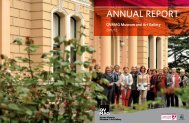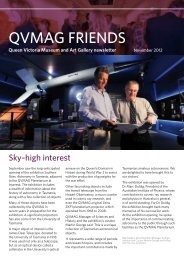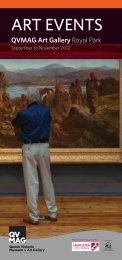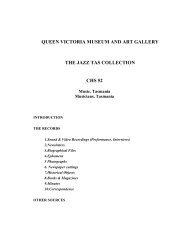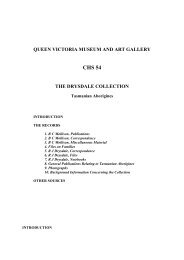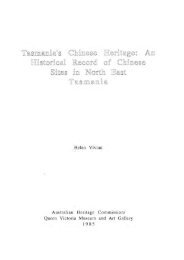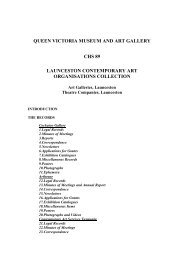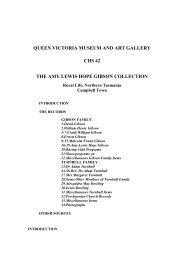Greening Inveresk Precinct: - Queen Victoria Museum and Art Gallery
Greening Inveresk Precinct: - Queen Victoria Museum and Art Gallery
Greening Inveresk Precinct: - Queen Victoria Museum and Art Gallery
Create successful ePaper yourself
Turn your PDF publications into a flip-book with our unique Google optimized e-Paper software.
<strong>Greening</strong><br />
<strong>Inveresk</strong><br />
<strong>Precinct</strong>:<br />
Towards Water <strong>and</strong><br />
Energy Sustainability
Launceston City Council I <strong>Greening</strong> <strong>Inveresk</strong> <strong>Precinct</strong><br />
2
Launceston City Council I <strong>Greening</strong> <strong>Inveresk</strong> <strong>Precinct</strong><br />
Executive summary<br />
The <strong>Inveresk</strong> Green <strong>Precinct</strong> Project: Towards Energy <strong>and</strong> Water Sustainability focussed<br />
on cost effective changes to existing buildings to achieve energy <strong>and</strong> water savings. The<br />
project was based at the Launceston City Council owned Aurora Stadium <strong>and</strong> the QVMAG<br />
<strong>Museum</strong> at <strong>Inveresk</strong>. A further program called EcoSmartBiz assisted <strong>and</strong> encouraged local<br />
small businesses to carry out their own efficiency measures.<br />
The objectives for the <strong>Inveresk</strong> Green <strong>Precinct</strong> Project were to:<br />
• Minimise energy <strong>and</strong> water consumption in the Aurora Stadium <strong>and</strong> the <strong>Museum</strong><br />
using cost effective measures<br />
• Encourage <strong>and</strong> educate the community to carry out similar achievement using the<br />
sites as a demonstration<br />
The <strong>Inveresk</strong> Green <strong>Precinct</strong> Project was completed in March 2012. The outcomes have<br />
been excellent <strong>and</strong> both facilities have been reinvigorated with state of the art efficiency<br />
systems <strong>and</strong> infrastructure. The facilities are now well established to be valuable <strong>and</strong><br />
informative demonstrations to the public.<br />
This report provides an overview of the following:<br />
• QVMAG <strong>Museum</strong><br />
• Aurora Stadium<br />
• EcoSmartBiz project with small businesses<br />
• Community engagement<br />
Overview<br />
The $1.576m <strong>Inveresk</strong> Green <strong>Precinct</strong> Project received $788,000 from the Australian<br />
Government’s Green <strong>Precinct</strong>s Fund. It was one of 13 sites around the country to receive<br />
funding for water <strong>and</strong> energy saving projects under the Green <strong>Precinct</strong>s Fund.<br />
Tasmania’s highest profile sporting facility, Aurora Stadium is a multi purpose venue that<br />
has played host to a variety of events ranging from a Rugby World Cup to regular AFL<br />
fixtures involving the Hawthorn Football Club at their Tasmanian home away from home.<br />
The QVMAG <strong>Museum</strong> is located within the former railyards site is the largest museum <strong>and</strong><br />
art gallery in Australia located outside a capital city.<br />
The <strong>Inveresk</strong> <strong>Precinct</strong> has positioned itself as a community hub of culture, creativity,<br />
innovation <strong>and</strong> recreation. There are few other places where there is such a combination<br />
of sporting facilities, educational institutions, a gallery <strong>and</strong> museum, as well as a host of<br />
other community <strong>and</strong> commercial facilities.<br />
Both facilities are ideally placed to be the central location <strong>and</strong> focus for raising awareness<br />
<strong>and</strong> encouraging the uptake of efficiency measures by individuals, households, commerce<br />
<strong>and</strong> industry. In particular the project demonstrates how to make cost effective efficiency<br />
changes to existing <strong>and</strong> old buildings that improve the functionality of the facilities whilst<br />
saving energy <strong>and</strong> water.<br />
The <strong>Inveresk</strong> <strong>Precinct</strong> has positioned<br />
itself as a community hub of culture,<br />
creativity, innovation <strong>and</strong> recreation 3
Launceston City Council I <strong>Greening</strong> <strong>Inveresk</strong> <strong>Precinct</strong><br />
QVMAG <strong>Museum</strong><br />
The focus at the QVMAG <strong>Museum</strong> was to reduce energy consumption in all parts of the<br />
facility. Following the initial energy audit a list of opportunities was gathered <strong>and</strong> those<br />
with the best outcome were chosen to be implemented. The outcome of the energy<br />
efficiency works was a reduction in electrical consumption of 27 per cent. This equates to<br />
425,000kWh saved per year.<br />
Lighting<br />
Lighting accounts for 25 per cent of total energy usage in each of the facilities. This then<br />
was an obvious area of research <strong>and</strong> trial to find suitable efficient lights. Another issue to<br />
overcome was the very large number of different light fittings <strong>and</strong> lighting requirement in<br />
both facilities so each area had to be assessed individually. The following upgrades were<br />
implemented:<br />
• St<strong>and</strong>ard fluorescent lights were changed to efficient T5 lights with electronic ballasts<br />
halving energy consumption whilst maintaining light levels<br />
• In selected areas fluorescent fittings were delamped which involves removing both<br />
the tubes <strong>and</strong> installing a single new quad phosphor tube with a reflector.<br />
• LED down lights replaced st<strong>and</strong>ard halogen lights saving 70 per cent energy.<br />
• LED flood lights were installed for outside night time security lighting<br />
• LED strip lighting for museum cabinet displays<br />
• Compact fluorescent lights<br />
• Motion sensors <strong>and</strong> lux controls to automatically turn lights off <strong>and</strong> on<br />
QVMAG <strong>Museum</strong> display using LED lights.<br />
In addition to changing the types of lights we also changed the way they operated by<br />
employing smart controls.<br />
A Dynalite timer system was installed to control the display lights in both the John Lees<br />
Atrium <strong>and</strong> the Temporary <strong>Gallery</strong> to turn on at a predetermined time just prior to the public<br />
opening each morning. The system allows just a few lights to turn on when employees first<br />
arrive so they can do their inspections in the <strong>Gallery</strong>. Then the remaining gallery lights<br />
automatically turn on at 9.50am before the public opening at 10.00am. The Potter <strong>Gallery</strong><br />
also has a Dynalite lighting system but it was installed separately as it is on another circuit.<br />
4
Launceston City Council I <strong>Greening</strong> <strong>Inveresk</strong> <strong>Precinct</strong><br />
Heating <strong>and</strong> ventilation<br />
The heating/cooling system is the largest energy using element at the QVMAG <strong>Museum</strong>.<br />
Typically air h<strong>and</strong>ling units are set up to take in outside air to ensure sufficient fresh air<br />
is inside the building. However, during times when rooms are unoccupied it is possible to<br />
reduce the outside air intake thus reducing the volume of air requiring heating or cooling.<br />
CO 2 sensors were installed in the main rooms <strong>and</strong> when levels drop below a set point<br />
the outside air dampers close off completely <strong>and</strong> air is recirculated in the system. The<br />
CO 2 control will provide significant savings based on reduced heating/cooling load by<br />
optimising the use of recirculated air in the building.<br />
Radiant heater control<br />
Radiant heaters mounted on the ceiling are used in several buildings during winter.<br />
Typically the heaters were left on over night as the rooms were too cold in the morning. An<br />
automated timer was installed so if the rooms were to be used the following day a button<br />
was pressed which initiated a timer relay. This then automatically tuned the heaters on at<br />
a predetermined time, typically about two hours before the rooms were used.<br />
Timer relays<br />
The lighting system in the John Lees, Railway <strong>and</strong> Planetarium Galleries have also been<br />
upgraded with a new timer system. In these Galleries a special clock was installed so<br />
that when employees arrive in the morning just a few lights turn on in each gallery so<br />
the employees can carry out normal duties. Then just before opening to the public all the<br />
remaining gallery lights turn on. This saves around two hours of full lighting load each day.<br />
Other project benefits<br />
Other than the obvious benefit of reduced four energy costs the work has resulted in some<br />
other advantages. The use of LED lights increases the life of the fixtures <strong>and</strong> minimise<br />
maintenance costs. The lights run cooler than the old lights also minimising cooling costs<br />
in summer.<br />
The use of presence <strong>and</strong> lux sensors means the lights turn on <strong>and</strong> off automatically which<br />
employees readily get used to <strong>and</strong> it means lights are no longer left on over night.<br />
The use of LED lights has been embraced by QVMAG <strong>Museum</strong> employees for exhibit<br />
lighting through out the <strong>Museum</strong> as this lighting has no UV <strong>and</strong> is available in many<br />
different forms which suit the large range of displays requirements.<br />
The knowledge gained from this project has been used in other Council facilities to reduce<br />
energy consumption <strong>and</strong> improve lighting conditions.<br />
The outcome of the energy efficiency<br />
works was a reduction in electrical<br />
consumption of 27 per cent. This<br />
equates to 425,000kWh saved per year. 5
Launceston City Council I <strong>Greening</strong> <strong>Inveresk</strong> <strong>Precinct</strong><br />
The expected water savings will be 15,400KL per year<br />
across Aurora Stadium, Invermay Park <strong>and</strong> the QVMAG<br />
<strong>Museum</strong> grounds which will be a 22 per cent reduction.<br />
6
Launceston City Council I <strong>Greening</strong> <strong>Inveresk</strong> <strong>Precinct</strong><br />
Aurora Stadium<br />
Water efficiency<br />
The majority of water consumption at the ground is used for toilet flushing <strong>and</strong> irrigation.<br />
The project focussed on capturing rain water from the Stadium roofs <strong>and</strong> storing for use in<br />
toilets around the ground. The new northern st<strong>and</strong> was fitted out with water tanks holding<br />
36,000 litres of rain water. The Railway Workers Hill was fitted with tanks to store 75,000<br />
litres <strong>and</strong> the adjacent Invermay Park has tanks to store 60,000 litres of water. The building<br />
management system is linked to all storages so water usage can be calculated.<br />
The irrigation of the lawns near the <strong>Inveresk</strong> Car Park was upgraded to more efficient<br />
sprinklers with a centrally located control point. Sprinklers are turned on with a telemetry<br />
system allowing for much easier control of the irrigation cycle resulting in less wastage.<br />
The water consumption data for January to March 2012 compared to similar periods prior<br />
to the efficiency works show the daily consumption dropping from 130kL/day to 65KL/<br />
day. However it will not be until a full 12 months that we will know the exact reduction. The<br />
expected savings will be 15,400KL per year across Aurora Stadium, Invermay Park <strong>and</strong> the<br />
QVMAG <strong>Museum</strong> grounds which will be a 22 per cent reduction.<br />
Energy efficiency<br />
All down lights were changed to LED lights <strong>and</strong> fluorescent tubes were changed to T5 22<br />
watt lights. Where possible movement sensors were fitted to automatically turn lights off<br />
when areas are not used. Outside flood lights were changed over to LED floods using a<br />
fraction of the power. Security/exit signs originally using 10 watt globes were replaced<br />
with new LED signs using 1.7 watts.<br />
The new Northern St<strong>and</strong> <strong>and</strong> the renovated Invermay Park change rooms were fitted with<br />
natural gas showers instead of the st<strong>and</strong>ard electric hot water storage units.<br />
The outcome of the work has resulted in reducing the annual energy consumption by<br />
approximately 100,000kWh per year which is a 15 per cent reduction.<br />
The old lights that were replaced at Aurora Stadium.<br />
7
Launceston City Council I <strong>Greening</strong> <strong>Inveresk</strong> <strong>Precinct</strong><br />
EcoSmartBiz<br />
The EcoSmartBiz Program was aimed to assist a number of small businesses become more<br />
sustainable <strong>and</strong> at the same time as promoting their achievements to the wider business<br />
community. The Program initially attracted 16 small businesses which were assisted with<br />
energy, water <strong>and</strong> waste audits <strong>and</strong> action plans for improvements. The businesses were<br />
assisted with workshops <strong>and</strong> one on one help. In the end eight businesses completed the<br />
program saving $9,700 in energy costs which on average is $1212 per business. A total of<br />
43,190kWh were saved through the Program with the eight businesses.<br />
A new LED floodlight on one of the buildings at QVMAG.<br />
Community engagement<br />
A number of events <strong>and</strong> strategies have been used to engage with the wider community<br />
regarding the project <strong>and</strong> the benefits of a more sustainable life.<br />
• Green <strong>Precinct</strong> Open Day involving energy efficiency workshops, lectures, site tours <strong>and</strong><br />
an evening of conversations with sustainability guru Tanya Ha <strong>and</strong> Professor Chris Ryan.<br />
• Opening of the new Northern St<strong>and</strong> at Aurora Stadium by the Prime Minister Julia Gillard.<br />
• At Aurora Stadium a partnership with the Hawthorn Football Club resulted in a massive<br />
recycling scheme to reduce material going to l<strong>and</strong>fill<br />
• Tours of the facilities are available to interested groups to showcase the efficiency<br />
measures<br />
• Completion of a nine minute animation film called the “Adventures of Shane <strong>and</strong><br />
Captain Sparks” which is permanently displayed on a monitor at the QVMAG <strong>Museum</strong>.<br />
The film explains in an entertaining <strong>and</strong> informative way where energy comes from,<br />
what energy efficiency is <strong>and</strong> what was achieved at the <strong>Museum</strong>. There are also<br />
tips for the public on what they can do at home <strong>and</strong> the work place to become more<br />
efficient.<br />
8<br />
Partnerships<br />
The Green <strong>Precinct</strong> Project involved a number of partners which all played their part to<br />
make the project an outst<strong>and</strong>ing success. The partners involved were:<br />
University of Tasmania<br />
Tasmanian Department of Environment, Parks, Heritage <strong>and</strong> <strong>Art</strong>s<br />
NRM North<br />
Net Balance<br />
Mance Electrical<br />
Contact Electrical<br />
Brown Bread <strong>and</strong> Butter
Launceston City Council I <strong>Greening</strong> <strong>Inveresk</strong> <strong>Precinct</strong><br />
9
Launceston City Council I <strong>Greening</strong> <strong>Inveresk</strong> <strong>Precinct</strong><br />
The project demonstrates that through well planned<br />
efficiency measures it is possible to save significant<br />
amounts of energy <strong>and</strong> water.<br />
10
Launceston City Council I <strong>Greening</strong> <strong>Inveresk</strong> <strong>Precinct</strong><br />
Lessons learnt<br />
1. The users of the buildings need to be involved from day one.<br />
The specific use of rooms <strong>and</strong> work places needs to be understood before any changes<br />
are made. The best way to achieve this is to involve those who use the space so they are<br />
part of the solution.<br />
2. Complete small scale trials first<br />
Trials are beneficial so that the technology can be tested <strong>and</strong> measured before committing<br />
to a large scale retrofit. Unforseen circumstances will be come evident during this process<br />
avoiding costly <strong>and</strong> time consuming issues arising later on.<br />
3. You get what you pay for<br />
Lights, particularly new LED ones require some research to ensure you are getting what<br />
you require. Cheap lights invariably have some drawbacks. We found it better to buy top<br />
of the range fittings as they are better quality.<br />
4. Question everything<br />
We found that the way buildings are operated is often a result of habit. Invariably building<br />
management personnel stated “that’s the way we have always done it” when questioned<br />
why they heated some rooms or left lights on. We challenged everything they did <strong>and</strong><br />
suggested how it could be done differently to save energy or water. Invariably we made<br />
changes that also improved the operation of the facility <strong>and</strong> reduced maintenance costs<br />
at the same time.<br />
Replacing fluorescent tubes with T5 lights.<br />
11
Town Hall, St John Street<br />
PO Box 396, LAUNCESTON TAS 7250<br />
T 03 6323 3000 TTY 03 6323 3003 F 03 6323 3001<br />
E council@launceston.tas.gov.au<br />
www.launceston.tas.gov.au



